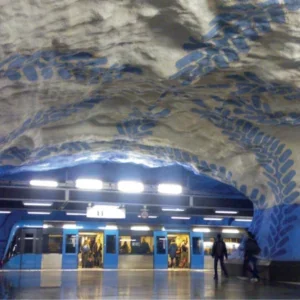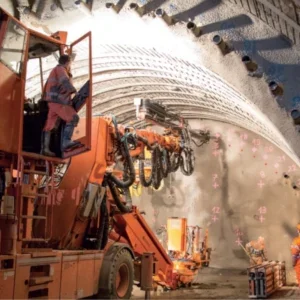For its size and population – about 260 000 residents on an island of 800km² – the Portuguese island of Madeira is a hot spot for tunnelling. More than 15km of road and highway tunnelling are currently being excavated on the island to improve connections, shorten travel times and upgrade the tangle of roads that cling precariously to the steep cliffs of the volcanic outcrop as it rises 1800m from the Atlantic.
Improving the road system to protect it from frequent landslides and help it cope with increasing traffic became a priority for Madeira’s autonomous government in the early 1990s, when substantial amounts of public funding were allocated to the current road building programme. Routes of particular importance included a bypass around the capital, Funchal; a link between Funchal and the island’s airport; a new link across the island from Ponta do Sol on the south coast to São Vicente on the north, with an extension to Porto Moniz to the north west; and an extension of the Funchal highway west from Camara de Lobos to Ribeira Brava.
The programme calls for more than 35km of new road and highway, of which more than 30km run through some 31 tunnels.
In the highly variable volcanic ground of Madeira, tunnelling involves a combination of drill+blast excavation with immediate shotcrete protection and support, together with rockbolts, steel arches and wire mesh. Geological conditions range from extremely hard basalt and dolerite to very weak breccia and volcanic ash or tuff. Groundwater ingress through the porous rock formations and fissures is a constant concern for tunnellers, and most tunnels have a waterproofing membrane behind the final 250mm thick in-situ concrete lining.
In these conditions, where speed of shotcrete application is imperative for the stability of the excavations and the safety of the workers, the contractors rely on the high-speed, high-volume and high-quality productivity of the shotcrete equipment. From AL-500 fully equipped mobile shotcreting rigs to the smaller portable AL-262 stand-alone units, many of the 13 or more Aliva units working on Madeira today were previously used on projects for the Lisbon Metro and new units have been added.
Both wet and dry mix shotcrete is being used and volumes of up to 16m³/h of shotcrete are being applied by the big AL-285 rotor pumps carried on the AL-500 rigs. Shotcrete additives and plastic waterproofing membranes from Aliva’s parent company Sika are also being used on various tunnel contracts.
Most of the contractors engaged in the road construction programme on Madeira are from Portugal, with JV partners from Brazil. Although the island’s narrow, mountainous roads are part of its charm, once completed, the new roads with their lengths of tunnel will make for much safer and more comfortable motoring around this beautiful island.
North-south link
The longest tunnel in the road building programme is the 3.1km long Encumeada Tunnel in the centre of the island between the towns of Serra de Agua and Rosario. The 70m², 2-lane tunnel having one lane of traffic in each direction is being built by contractor EPOS. The tunnel is being excavated from both portals through highly variable geological conditions which change quickly from hard basalt rock to weak tuff. High inflows of groundwater are frequent.
To achieve rapid support and closure of each exposed round of tunnel, EPOS is using the high mobility and high productivity of two AL-500 shotcrete rigs, one at each portal heading. The sturdy wheel-based chassis of the AL-500 rig can be driven to position near the face and quickly set ready for shotcreting. There need be no delay between the mucking out and initial shotcreting cycles or between the blast and the application of a flash layer of shotcrete to protect the rock and provide a safe environment for mucking out.
EPOS is employing the semi-wet shotcreting method whereby water and accelerator are added to the dry-mix ingredients about 3m back from the spraying nozzle. Injection of the liquid additives to the hose at this point ensures a thorough pre-mixing of the water and accelerator with the dry ingredients to achieve a high quality application on the tunnel walls. It reduces the rebound and the dust normally associated with dry mix shotcreting and activates the curing process slightly earlier to achieve early strength more quickly than is usual with the normal dry mix method.
At the time of writing, EPOS had completed a total of about 1.5km (900m from the south portal and 600m from the north). Once completed, in November 2000, the 3.1km long Encumeada Tunnel will cut about 20 minutes off the current north-south journey up and over the Serra de Agua Mountain.
São Vicente to Porto Moniz
|
“In the early 1990s, substantial amounts of public funding were allocated to the current road building programme” |
There are five tunnels on the north coast link from São Vicente to Porto Moniz. These are being built by local Madeira contractor Tecnorocha, which has built more than 40 tunnels on the island over the years. Again, single-tube, 2-lane tunnels for 2-way traffic, these 70m² tunnels range from 375m to 1.2km long and carry the coastal road through the volcanic ridges to eliminate dangerous hairpin bends around the cliffs and rockfalls from the steep cliffs above.
For its shotcreting requirements, Tecnorocha is also using an AL-500 rig fitted with an AL-285 rotor shotcrete pump for wet mix spraying. During the site visit to Madeira, the potential for dangerous landslides was witnessed when two cars collided head-on while negotiating the tight, blind bends on the existing coastal road. Fortunately, there were no fatalities but the accident took some time to clear and held up through traffic for a long time. The new tunnels are scheduled to open in summer 2000.
Tecnorocha is also excavating the 2.5km long single-tube, 2-lane tunnel on the south west coast to provide a direct route between Jardim do Mar and Paul do Mar and avoid the long, circuitous route via Prazeres to get from one to the other. In addition, it is building the 2.1km long Tunnel do Norte through the mountains between Ribeira de Machico and Referta to create a 2-way expressway between Machico on the east coast and Ribeira do Faial on the north east coast via Porto da Cruz. For these tunnels, Tecnorocha is using an AL-500 rig for dry mix shotcrete and two AL-262 units, also for dry mix shotcreting.
Twin-tube highway tunnels
The airport highway link and the Funchal bypass are 4-lane expressways and include twin-tube, 4-lane tunnels for 2-lane traffic in each direction. Zagope of Portugal is the contractor for the three twin-tube tunnels on the Funchal bypass, or Via Rapida. It is known as the Cota 2000 project and Zagope is in JV with local Madeira contractor Tamega for the six tunnels on the airport link, three of which are twin-tube.
On the airport link, Tamega-Zagope is using two AL-500 mobile shotcreting rigs previously used on the Lisbon Metro and still in fine condition after spraying approximately 30 000m³ of shotcrete and spending more than 3000h in production. The JV also has an AL-262 with an AL-403 additive dosing unit for wet mix spraying.
On the Via Rapida bypass, Zagope is excavating a total of about 3.5km of 70m² of 2-lane tunnel with single tube adits of about 36m² which provide the on and off ramps to the in-tunnel expressway. An AL-500 and two AL-262 units are spraying wet mix, thin-stream shotcrete in the excavations. Some 50% of the bypass project opened to traffic in 1998 and the remainder is due to open at the end of this year.
As in all tunnels on the island, geological conditions are highly variable and unpredictable. The contractors on both projects are using 450-500kg of cement/m³ in their wet mix shotcrete and aggregate of 0-16mm in size. Tamega and Zagope are very pleased with the immediate support and security offered by the high productivity of the shotcreting equipment in such difficult geology.
South coast improvements
Another four single-tube, 2-lane tunnels are under construction by contractor Avelino Farinha & Agrela to improve connections between Tábua and Ponta do Sol and from Calheta to Frazeres on the south coast. The two tunnels near Ponta do Sol, at 630m and 730m long, were due to open in summer 1999, while the two near Calheta, at 800m and 500m long, will open in mid-2000. At Ponta do Sol, a massive rockfall took away a section of cliff that was to form the centre of one of the tunnels, so the east heading was diverted further into the mountain and a new west side portal created. The disconnected west section of the tunnel, excavated before the land slide, is being used as an underground public car park for the town. On its tunnel headings, Avelino Farinha & Agrela is using two AL-262 machines for dry mix shotcreting.
Funchal – Ribeira Brava expressway
The current rash of tunnelling started five years ago, when ten twin-tube tunnels were excavated as part of the 8km long Funchal-Ribeira Brava expressway. Opened to traffic in 1996 and 1997, some 5.5km of the expressway runs in tunnel. Because of the benefits of this initial programme, the regional government and Municipality of Funchal decided to adopt an extended tunnelling programme. Aliva equipment was used on the earlier tunnel and the contractors have bought additional units for the later tunnels from Maquinter, the manufacturer’s Portuguese agent in Lisbon.
Related Files
Location Map






